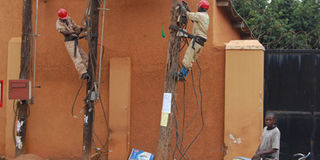Electricity tariffs could rise over shortfall in generation

Workers connect people onto power in Kampala. The electricity transmitter says they have been constrained by low water supply to the hydropower facilities despite the recent increase in rainfall around the country. PHOTO BY FAISWAL KASIRYE
What you need to know:
Mr Simon Kasyate, the corporate affairs manager of Eskom, the firm managing a 20- year concession for Uganda Generation Company Limited (UEGCL), however, said the status quo is not bad as it is painted
Kampala. Uganda Electricity Transmission Company Limited (UETCL) has said power tariffs could go up again, anytime, once they revert to buying thermal power because current generation from the country’s two main hydro generators— Bujagali and Eskom— is not enough.
UETCL’s head of communications Kenneth Otim told Daily Monitor last week, they have been constrained by low water supply to the hydropower facilities despite the recent increase in rainfall around the country. This, he said, leaves no alternative but to switch to thermal generators, which recently had been limited to supplying only seven megawatts (MW) to the grid.
“Our power demand has currently risen to 530MW (from 500MW) against the current generation capacity of 530MW at peak time that keeps fluctuating due to hydrological conditions (generation is high during the rainy seasons and low during dry spell),” Mr Otim said.
The power regulator, Electricity Regulatory Authority (ERA), early this month had already announced an increase in power tariffs, citing the weak Shilling against the dollar.
The Authority is expected to revise power tariffs again in the next two months.
Power demand, according to UETCL, has grown to 10 per cent per annum against the country’s installed generation capacity estimated at 818MW.
In reverting to thermal, Mr Otim explained the two plants— Jacobsen (50MW) and Electromaxx (50MW)—will, in the medium-term, meet the growing demand as government awaits the commissioning of the Isimba 183MW and Karuma 600MW hydro-power plants expected around 2018.
“We are trying to move away from the position of mitigating power emergency situations into a short-term power surplus situation, facilitate new power production, invest in new transmission lines and increase regional power cooperation-(ongoing constructions of the regional power interconnections with Kenya and Rwanda),” he added. “Our only advantage for now is that demand is still fluctuating around 530MW and generation 530MW but it is not sustainable.”
Eskom generates 200MW at peak from Nalubale and Kiira hydro plants while Bujagali generates 250MW.
UEGCL’s CEO Harrison Mutikanga said he cannot dispute UETCL’s projections, saying: “Generation is still slightly higher than demand from what I know but then one might wonder why there is still load shedding in some parts of the country, which is as a result of bottlenecks in transmission and distribution.”
Mr Simon Kasyate, the corporate affairs manager of Eskom, the firm managing a 20- year concession for Uganda Generation Company Limited (UEGCL), however, said the status quo is not bad as it is painted.
“Installed generation capacity at present is 850MW; peak time demand is indeed 530 MW meaning capacity supply is higher than demand. What is true is that demand is growing; some industry sources quote 10 per cent growth. But with Isimba and Karuma expected in two to three years, it’s unlikely we shall go back to the dark ages.”




